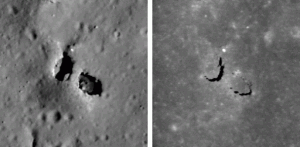Three Ships, Two Bridges, One Freaky Rocket
by wjw on September 9, 2010
From the Discoveries High and Low Department.
Via Geoff Landis, the Lunar Reconnaissance Orbiter has discovered two natural bridges on the moon.

In a first, the Lunar Reconnaissance Orbiter camera team spotted a natural bridge on the Moon in an image from King crater, on the lunar farside. The bridge appears to have formed when two adjacent sections of roof collapsed into an underground void, leaving a small section of uncollapsed roof between them. Such collapses are commonly theorized to form into lunar lava tubes, but this region is not associated with lunar volcanism; instead, the collapse appears within the impact melt sheet of King, a very fresh, moderately sized (77-kilometer-diameter) crater.
Sending rockets into space using a combustible mixture of on-board fuel isn’t an optimal solution to the problem of escaping Earth’s deep gravity well. Not only is it dangerous to strap humans and satellites on top of giant bombs, it’s also incredibly wasteful: 90% of the weight of a rocket sitting on the launch pad is fuel.
The latest demonstration used a Gyrotron – essentially a maser – at the Naka Fusion Institute of the Japan Atomic Energy Agency. (This super high-powered microwave beam emitter was originally developed as part of Japan’s contribution to ITER, the international effort to create a workable fusion reactor.)
Using this beam, the scientists were able to send pulses of microwave energy into the bottom of their hollow 126 gram rocket model, heating the air within to 10,000 degrees Celsius and resulting in its rapid expansion. The result is a little boom, “like thunder.”
Presumably there’s a lot of work to be done before their teeny-tiny rocket can be scaled up to chimp-chucking size.
As above, so below. Three shipwrecks have been discovered off Cyprus that chart the shift from classical ship designe (rowed galleys) to modern ships (powered by wind).
The remains of the three craft — all dating from between 1450 and 1600 — were found in the straits between Turkey and the Greek island of Rhodes. One ship appears to be a large English merchant ship, while the other two are smaller — perhaps a patrol craft from Rhodes and a small trading boat that could have been Turkish, Italian or Greek . . .
To discover the shipwrecks the researchers used a combination of advanced technology, and persistence.
“We map the seafloor with a really intense sonar system that makes very accurate detailed maps of the seafloor,” Royal told LiveScience. “Once we examine those maps we can tell anomalies that may be cultural remains versus geology.”
When sign of possible shipwrecks appeared, the researchers sent down automated robots with lamps and cameras and robotic arms, which confirmed there were remains.
Underwater archaeology is going through an enormous expansion thanks to new detection technology. Over 200 wrecks have been discovered between Italy and Carthage, many probably dating to the Punic Wars. I don’t know that any of these have actually been explored, since the money to properly explore wrecks lags behind their discovery.
Famous ships recently discovered include Blackbeard’s Queen Anne’s Revenge, Captain Kidd’s Quedagh Merchant, a nameless ship buried under sand in Namibia filled with ivory and gold, the Nuestra Senora de las Mercedes (laden with $500 million in Peruvian silver), the Graf Zeppelin (Hitler’s only aircraft carrier, lost at the end of the war), and the HMS Victory— not Nelson’s Victory, which is in Portsmouth harbor, but an earlier incarnation lost at sea in 1744.
We’re discovering things left, right, and center. Someone should name one of them after someone like, ummm, me!
Previous post: Om Shanti Om
Next post: The Matrix Dude

“Peruvian silver”… Curious. The Nuestra Señora de las Mercedes was sunk in 1804, and Peru achieved independence in 1821, so legally it was a Spanish ship with Spanish silver.
The Mercedes was the subject of a vast lawsuit, with both Spain and Peru challenging the salvage company in court. The site of the wreck has remained secret, but Spain claims it was in their territorial waters.
Spain won the lawsuit, last I checked.
http://www.telegraph.co.uk/news/worldnews/europe/spain/5444134/Treasure-hunters-ordered-to-pay-Spain-350m-for-gold-coins.html
Yes, I know about the lawsuit. Honestly, though I find Spain’s and Peru’s reclamations opportunistic, I also think that the salvage company’s acts (secrecy and lies, basically) amount to little more than robbery. But that’s irrelevant, I think.
My point is that, at the moment it happened, it was Spain, and Spanish silver. Or do you consider Rudyard Kipling an Indian writer because he was born in (then British) Bombay?
Comments on this entry are closed.